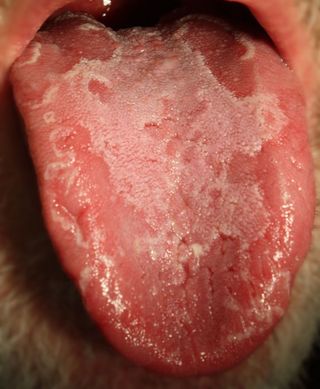The Tongue: Facts, Function & Diseases

Though the tongue may seem like a simple organ, it has a wide range of purposes, such as licking, breathing, tasting, swallowing and articulating speech. Its many talents are due to the construction of the tongue.
Size
Typically a human tongue is around 3.3 inches (8.5 centimeters) for men and 3.1 inches (7.9 cm) for women, according to the University of Edinburgh. The world’s longest tongue is 3.97 inches (10.1 cm) long, from the tip to the middle of the closed top lip, and belongs to Nick Stoeberl of Salinas, California, according to Guinness Book of World Records. The longest tongue for a woman is 3.8 inches (9.75 cm), belonging to Chanel Tapper of Los Angeles.
Function
The tongue consists of eight interwoven, striated muscles that can move in any direction, making it quite flexible. Throughout the muscles are glands and fat, while the outside is covered by a mucus membrane. The top of the tongue, also called the dorsum, is covered with papillae, tiny nodes that contain the taste buds and the serous glands.
The serous glands secrete some of the fluid found in saliva, while the taste buds taste food through receptors that send information to the brain. Receptors are nerve endings that have a chemical reaction to the food that is being eaten. There are different reactors for different types of flavors, and there are around 50 to 150 taste receptor cells inside each taste bud, according to Encyclopedia Britannica.
It is a myth that different parts of the tongue taste different things. While it is true that different receptors taste different flavors, these various receptors are bunched in four places on the tongue. Most of the taste receptors are found on the tip of the tongue, according to the University of Texas Medical Branch.
The bottom of the tongue is smooth. Its purple color comes from the many blood vessels that run along the bottom of the tongue.
The root of the tongue is the bottom part of the tongue that can't be seen. It has arteries, bundles of nerves and muscles that branch out to the rest of the tongue.
Sticking it out
Sticking out your tongue is considered unacceptable behavior in many cultures, but it is a sign of respect in others, according to Bright Hub Education. In Tibet, sticking out the tongue is a greeting. When two people meet, they stick out their tongues at each other. Among the Maori people of New Zealand, sticking out the tongue is part of a war chant and is meant to intimidate the enemy. If a Maori woman sticks out her tongue, it is a sign of defiance. [Infographic: Will Your Tongue Really Stick to a Frozen Flagpole?]

Diseases & conditions
Though the tongue is small, it can develop many different conditions. "The most common condition that I see as a dentist is [oral] erythema migrans, aka 'geographic tongue,'" said Dr. Corbin Brady of Brady Dental Care in Des Moines, Iowa. This condition is characterized by red patches on the tongue with a yellow or white serpentine border that disappears and reappears on different parts of the tongue. "Its etiology is unknown and no known conditions seem to cause it. The good news is that no pain or symptoms are typically associated with it," said Brady. (Erythema migrans is also the name of a skin rash that is a symptom of Lyme disease. The two are not related.)
Like with geographic tongue, most shape changes or discoloration of the tongue, such as furry tongue or black or yellow coloring, are harmless.
Oral thrush, or oral candidiasis, is caused by an accumulation of a fungus on the lining of the mouth. It causes creamy white lesions on the tongue and inner cheeks, according to the Mayo Clinic. It is more likely to affect babies, the elderly and people with suppressed immune systems, such as people with HIV/AIDS.
Smoking can cause a wide variety of tongue problems. People who smoke often find that their sense of taste is deadened or changed. "Nicotine is a known vasoconstrictor, something that limits blood flow — it limits your bodies cells from functioning or healing. For the tongue, continued smoking has shown to alter the morphology of the fungiform papillae, which hold your taste buds. Smoker's papillae have been shown to typically be less dense in number, have less blood flow (less capillaries), and have thicker 'skin' (more keratin)," Brady said.
Smoking and other tobacco products can also cause tongue cancer. According to Cancer Treatment Centers of America, some of the symptoms may include:
- Difficulty swallowing or chewing
- Persistent tongue and/or jaw pain
- White or red patch on the gums, tongue, tonsil, or lining of the mouth
- A lump or thickening in the inside of the mouth
- Sore throat or feeling that something is caught in the throat that does not go away
- Difficulty moving the jaw or tongue
Additional resources
Sign up for the Live Science daily newsletter now
Get the world’s most fascinating discoveries delivered straight to your inbox.
